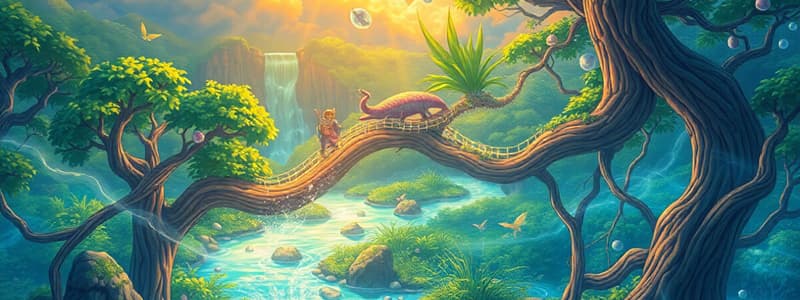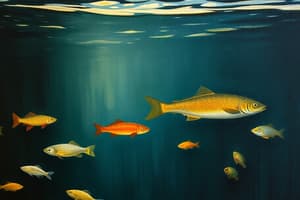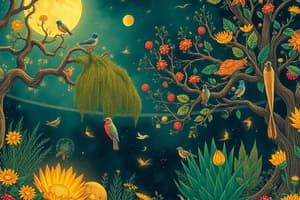Podcast
Questions and Answers
What is an ecosystem?
What is an ecosystem?
- A system with only biotic factors
- A system that only includes producers
- All of the organisms and abiotic factors in an area (correct)
- A closed system with limited energy flow
Ecosystems are closed systems where energy and matter cannot enter or exit.
Ecosystems are closed systems where energy and matter cannot enter or exit.
False (B)
What is the principal source of energy that sustains most ecosystems?
What is the principal source of energy that sustains most ecosystems?
Sunlight
What do producers convert solar energy into?
What do producers convert solar energy into?
In a food chain, something feeds on the last organism.
In a food chain, something feeds on the last organism.
Match the following terms with their definitions:
Match the following terms with their definitions:
What percentage of energy is typically lost between trophic levels?
What percentage of energy is typically lost between trophic levels?
What is GPP in ecological terms?
What is GPP in ecological terms?
What defines a tertiary consumer?
What defines a tertiary consumer?
Decomposers obtain energy from _____ organisms.
Decomposers obtain energy from _____ organisms.
Which of the following is true about photoautotrophs?
Which of the following is true about photoautotrophs?
Flashcards are hidden until you start studying
Study Notes
Ecosystems as open systems
- Ecosystems are open systems
- Matter and energy can enter and exit an ecosystem
- Organisms and abiotic factors make up an ecosystem
Sunlight as the primary energy source
- Photoautotrophs use sunlight to synthesize carbon compounds
- Chemoautotrophs use chemical reactions to generate energy
- Light intensity varies depending on the location and depth of the ecosystem
Flow of chemical energy through food chains
- Consumers obtain their energy from consuming producers or other consumers
- Arrows in food chains represent the flow of energy
- The last organism in a food chain is not consumed
Food webs and trophic levels
- Food webs show all possible food chains in a community
- Trophic levels categorize organisms based on their feeding position
- Primary producers are eaten by primary consumers, who are eaten by secondary consumers, and so on
Decomposers
- Decomposers obtain energy from dead organisms, feces, and discarded body parts
- Decomposers recycle nutrients
- Saprotrophs are decomposers that digest substances externally
- Detritivores are decomposers that digest substances internally
Autotrophs
- Autotrophs can synthesize all necessary carbon compounds from inorganic substances
- Examples of autotrophs include plants, algae, and cynobacteria
Photoautotrophs and chemoautotrophs
- Autotrophs use external energy sources for carbon fixation
- Photoautotrophs use sunlight as their energy source
- Chemoautotrophs use oxidation reactions as their energy source
- Chemoautotrophs harness energy from oxidizing iron
Heterotrophs
- Heterotrophs obtain carbon compounds from other organisms
- Heterotrophs use digestion to break down molecules for absorption and synthesis of new compounds
- Digestion can be internal (consuming, digesting, and absorbing) or external (releasing enzymes, digesting, and absorbing)
Cellular respiration
- All organisms need ATP
- All organisms produce ATP via cellular respiration
- All organisms oxidize carbon compounds to release energy for ATP production
- Autotrophs make their own carbon compounds and then oxidize them
- Heterotrophs oxidize carbon compounds they consume
Trophic levels
- Trophic levels describe an organism’s position in a food chain
- Primary producers are the first level, followed by primary consumers, and so on
- Each level contains organisms that consume the level beneath it
Energy pyramids
- Energy pyramids represent the flow of energy through trophic levels
- Energy pyramids are often stepped or scaled, not triangular
- The 10% rule states that about 90% of energy is lost at each trophic level
- Energy pyramids show the amount of energy available at each trophic level per unit of area per year
Energy loss between trophic levels
- About 90% of energy is lost between trophic levels due to:
- Cellular respiration
- Incomplete consumption
- Incomplete digestion
- Energy loss restricts the number of trophic levels in ecosystems
Heat loss
- Cellular respiration releases heat
- Heat cannot be converted into chemical energy
- Heat cannot be passed to the next trophic level
Restrictions on trophic level number
- Energy loss limits the length of food chains
- The amount of biomass at each level decreases with each trophic level
- There are fewer trophic levels due to energy loss
Primary production
- Primary production is the accumulation of carbon compounds in biomass by producers
- Gross primary production (GPP) is the total biomass of carbon compounds made by producers
- Net primary production (NPP) is the amount of biomass available to consumers after producers use some for respiration
- Different biomes have different primary production capacities
Secondary production
- Secondary production is the accumulation of carbon compounds in biomass by heterotrophs
- Secondary production declines with each trophic level
- Increased plant-based diets can increase productivity, since less energy is lost during the digestion of plant matter versus animal matter
Studying That Suits You
Use AI to generate personalized quizzes and flashcards to suit your learning preferences.




